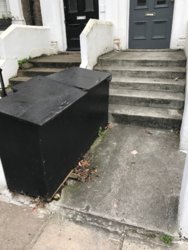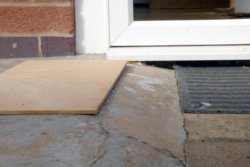It depends on how flat and level it is. You may need to render first if the wall is out of line (get a 2m straight edge and if you can see any gaps or humps larger than 3mm).
If it is flat enough, check the porosity of the brick. Class B's tend to be quite dense so there may not be any need for priming, but if you put some water on and it soaks relatively quickly, a diluted (1:1) acrylic primer (like BAL APD or Ardex P51) will be enough. Leave to dry and tile with an S1 flexible adhesive (the one you go for will depend on the type of tile you use).
Other things to consider:
1. If you are tiling above 3m high, you will need mechanical fixings. (hooks screwed into the wall that the tiles hang off, used as an addition to tile adhesive, not instead of.)
2. Don't be scared of using natural stone such as slate or limestone. [in my own personal opinion] It will look better than a porcelain imitation. Once installed and sealed correctly, they will need very little in the way of ongoing maintenance, apart from checking the sealer every 12 months and applying a further coat if required.
3. Vertical and horizontal movement joints will be needed every 3-4 metres but its recommended to reduce this to every 2m if using a dark stone or tile that will be in direct sunlight as it will attract extra heat, thus causing additional expansion (if this is the case, its also advisable to adjust your adhesive to an S2 flexible).
4. If it is a retaining wall, some form of moisture block or damp proof will be needed on the back if there is not one already present in the structure. This will be to prevent sulphates in the soil being carried through by water or rainfall, to the adhesive. If it does get through, it will slowly start to break the adhesive down, gradually reducing the bond strength, until *pop*, it gives up completely.
But other than that, should be fine 🙂







